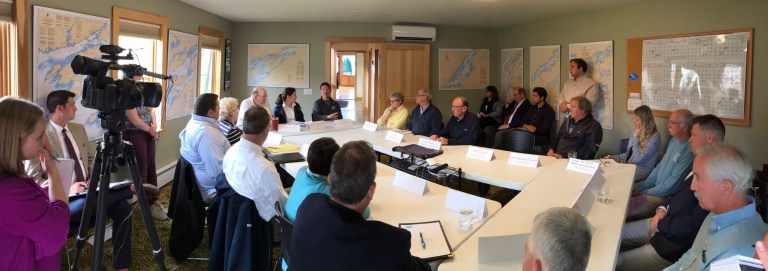Congresswoman Elise Stefanik and Save The River Host Roundtable Discussion
 On Wednesday, May 29 Congresswoman Stefanik visited Save The River for a working tour of the St. Lawrence River followed by a roundtable with local business owners, elected officials representing towns, villages, and counties along the River, and members of the International Joint Commission’s (IJC) International Lake Ontario-St. Lawrence River (ILOSLR) Board.
On Wednesday, May 29 Congresswoman Stefanik visited Save The River for a working tour of the St. Lawrence River followed by a roundtable with local business owners, elected officials representing towns, villages, and counties along the River, and members of the International Joint Commission’s (IJC) International Lake Ontario-St. Lawrence River (ILOSLR) Board.
Jeff Garnsey, president of Save The River’s board of directors, captained the boat tour that began with a look at the work done to protect the village of Clayton’s waterfront properties. Moving upriver the tour paused to float in Grindstone Island’s Flynn Bay where Captain Garnsey, a fifth-generation fishing guide, explained that the bay is one of the area’s most important northern pike and muskellunge hatcheries and the return of more natural water levels, supported by Plan 2014, will reduce the dense mat of cattails that have choked the bay’s shorelines and prevented these prized sport fish from reaching their historical breeding grounds. As the tour moved downstreamand back to Clayton, the group was able to view how waterfront residents are modifying their docks, boathouses, and homes to the adapt to the high-water levels.
Following the boat tour, Save The River and Congresswoman Stefanik hosted a roundtable discussion with a wide spectrum of voices including business and tourism leaders, local elected officials, and members of the IJC to discuss both the benefits of Plan 2014 and the concerns of Riverfront residents about the water levels. Tom Brown, a U.S. member of the IJC’s International Lake Ontario-St. Lawrence River Board, provided an educational background on the water level regulations plan (1958D) that historically governed the outflows of Lake Ontario and the St. Lawrence River and noted that that in reality Plan 2014 was not a dramatic change from prior plans but it acknowledges the critical importance of natural level fluctuations and accounts for previously unrepresented interests, including the environment and recreational boating. Brown, along with Save The River, reaffirmed the importance of moving forward with a continued commitment to Plan 2014, while acknowledging another important component of the plan: the Great Lakes Adaptive Management’s Committee who is tasked with the long-term adaptive management process to review and improve outflow regulation.
The discussion then turned to the extraordinary conditions that are causing high water levels on Lake Ontario and the St. Lawrence River this year including:
- all five of the Great Lakes currently dealing with above average water levels, including Lake Erie which has reached record highs in the month of May and represents 80% of the inflow entering Lake Ontario,
- significant spring runoff and heavy precipitation leading to the flooding of the Ottawa River basin, a water system that is nearly two and a half times the size of the Lake Ontario watershed basin, and which empties into the lower St. Lawrence River where it impacts downstream cities,
- such as Montreal which has faced historic flooding since mid-April with over 10,000 residents who have had to evacuate their homes, and
- above average precipitation throughout the region; Watertown has already recorded nearly double the average amount of rainfall for the month of May.
In short, Brown explained, “There is too much water upstream and there is too much downstream, there is nowhere for it to go.”
Rob Campany, also a U.S. member of the IJC’s International Lake Ontario-St. Lawrence River Board, discussed the delicate balancing act of maximizing outflows, especially during the winter months when the board must closely monitor ice formation and adjust outflows to allow the formation of a stable ice cover to prevent ice jams that can cause devastating destruction and inland flooding. Campany noted that in the months of December 2018 through February 2019 record high outflows were achieved, the fourth highest outflows in over 100 years of monitoring. Without the increased outflows this past winter, this year’s flooding would have been more significant.
Discussion around the table included concerns from downriver residents who experienced extreme low water levels in 2018, the economic importance of an extended boating season supported by Plan 2014, and recollections of high-water years in past decades including the 1970s. Ron Thomson, owner and operator of Uncle Sam Boat Tours, noted that with all of the area’s outstanding tourist attractions “…the number one attraction is the River itself, which means the health of the River is critical for our business.”
Congresswoman Stefanik wrapped up the meeting by addressing concerns about the Federal Emergency Management Agency’s (FEMA) response to local municipalities and encouraged local officials to contact her office so that they could work together to track FEMA applications. Stefanik also heard about the critical need for modern digital flood maps that are being created by FEMA across the nation but have not yet been created for the St. Lawrence River region; Stefanik noted that an official request will be made to prioritize mapping the River. Finally, Stefanik also commented that based on her conversations with Brown, Campany, and others it was clear that more work on shoreline resiliency was essential.
“It was important for Save The River to be able to take Congresswoman Stefanik and local leaders out on the River to see the measures being taken by the community and River residents to adapt to the high-water levels,” said John Peach, executive director of Save The River. “We’re grateful both for her ongoing support of Plan 2014 and for her response to our communities in these years’ of extreme conditions that create record high water levels.”
